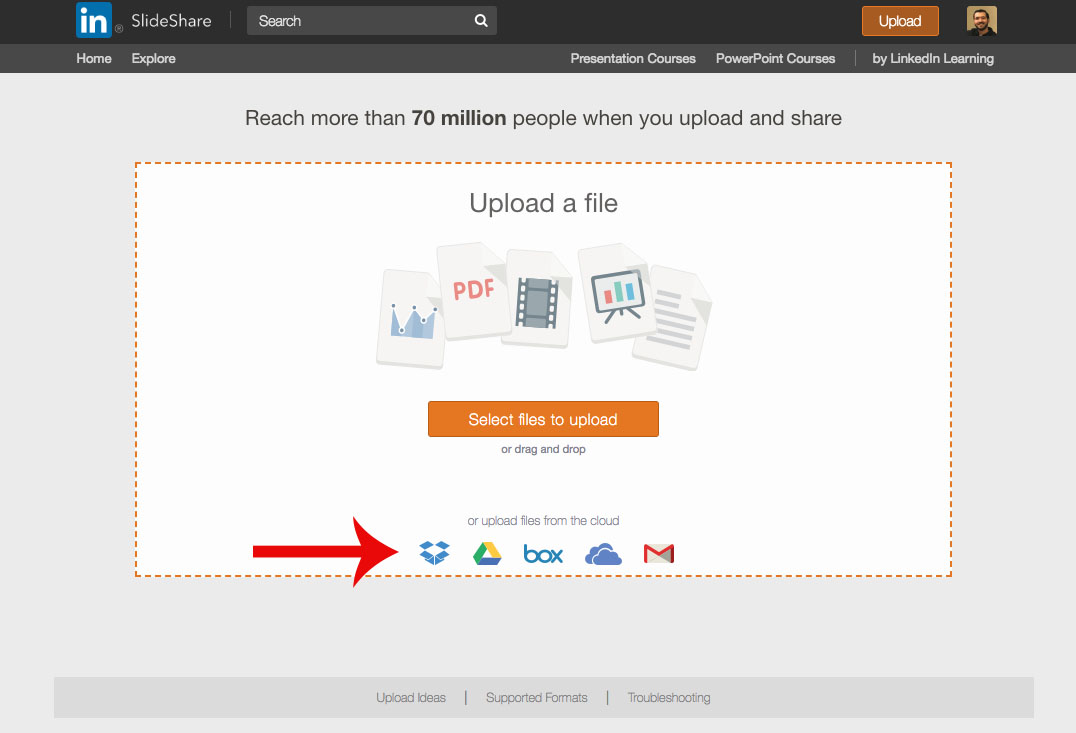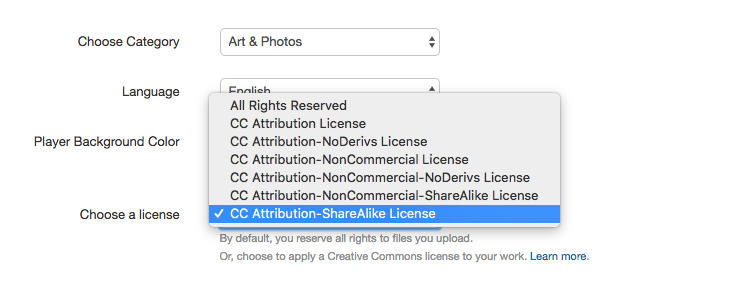← Go Back to the Impact Challenge Table of Contents

Image © GDC Europe licensed CC BY.
Your conference slides don’t get a lot of love, do they? You tend to use them to present at conferences, then throw ‘em in a virtual desk drawer and forget about them.
Yet slides are visual aids that help tell important stories about our scholarship. And they can be useful to those who weren’t able to see your talk in person. So, why not share them?
In today’s challenge, we’re going to get your slide decks on Slideshare so the world can see them.
But first: before you get started on Slideshare, make sure you’ve already uploaded any slide decks you want share to SHAREOK for all the reasons we covered in the SHAREOK chapter of this OU Impact Challenge (for one, it ensures your work will still be available long after Slideshare is gone).
Complete the Slideshare basics
Slideshare is a popular, free slide hosting service that many scholars use to share their conference and classroom lecture slides.
First things first: visit Slideshare.net and click “signup” in the upper right corner. Because you already have a LinkedIn account (You do have a LinkedIn account, right? From this previous chapter of the OU Impact Challenge?), click the “Sign in” link underneath the “Join LinkedIn” box. The “Upload” box in the upper right corner should turn orange.
Next, create your professional profile. If you created your Slideshare account using LinkedIn, some of your personal information from LinkedIn will already be imported. If not, here’s how to edit your profile:
- Hover over the person icon in the upper right corner; select “Account Settings” from the drop-down menu.
- Select “Profile Details” from the left-hand navigation bar. Click “Personal Details.”
- On the “Personal Details” page, add a photo (the same one you used for your LinkedIn account is perfect), your name, and information about where you work and what drives your research. Link to your website and click “Save.”
- On the “Contact Details” page, add links to your Twitter and LinkedIn profiles. Click “Save.”
Now, whenever anyone finds your slide decks on Slideshare, they’ll be able to easily learn more about you and your research, and they’ll be able to find you (and connect with you) on other sites.
What to upload
You can upload your PowerPoint, PDF, Keynote, and OpenDocument slides. PowerPoint and PDF work the best; we’ve occasionally had problems uploading Keynote slides.
If you encounter errors uploading your Keynote or OpenDocument slides, a good workaround is to save your slides in PDF format and then upload them.
If you’re like us, you often use the Notes portion of your PowerPoint slide deck to leave reminders to yourself to “cite So-and-so’s 2003 paper here” or to “break down definitions here for beginners.” Beware: others who download your slides can read these notes! Double-check your slides and their notes carefully before you upload a presentation to Slideshare. Sharing your speaker notes is a best practice when you’re careful, because it helps others make sense of your presentation – especially if there aren’t a lot of words on your slides.
Make uploading a snap
Next, we’re going to make it super simple for you to share your slides moving forward. To do that, we’ll need to connect your Slideshare account to the cloud storage platforms that your slides tend to live and set a default license for all the slides you share.
Connect to the cloud
If you’re like us, you tend to create your slide decks on your desktop and then add them to Dropbox or Google Drive when you’re ready to present. That way, you don’t have to fiddle with thumb drives when presenting. Slideshare connects to these cloud storage services, making it very easy to import your slide decks when they’re ready to share. 
To connect your accounts, click the orange “Upload” button in the upper right corner of the screen. On the next screen, click the “or upload files from cloud” link. Alternately, you can click on any tile at the bottom of the screen – they all open the same dialog box.
In the dialog box that appears, choose the cloud service or email provider you want to connect to. Connect your account, and then connect any other accounts you might use in the future to store your files. When you’re finished, exit from the dialog box and–that’s it! Your accounts are connected from here on out, so it will be very easy to transfer files to Slideshare in the future.
Set a default license
We’ll be covering licenses in next week’s Impact Challenge, but you can still apply a default license to your slides for now. An intellectual property license applied to your slides gives others a clear idea of how they can or cannot use your slides.
Slideshare allows you to either keep “All Rights Reserved” for your files or select a Creative Commons license. We recommend that you use a Creative Commons license if you’re sharing your scholarly slides. Doing so will allow others to blog about your work, cite you on Wikipedia, and reuse and share your work in other ways that can increase your impact.
To set a default license for your slides, hover over the person icon in the upper-right corner, choose “Account Settings,” then select the “Content” tab from the navigation bar on the left.
On the “Default License for your Content” drop-down menu, select the license you’d prefer. We recommend a CC Attribution-ShareAlike License, as it allows the most reuse and sharing of your content. But there are many considerations in choosing a license, so what we really recommend is choosing the license that best works for you. 
Got your default license selected and your cloud storage platforms connected? Now let’s share some slides!
Get your slides online
Choose a slide deck that you’re ready to share with the world. To get it onto Slideshare, click “Upload” in the upper right corner, and then find your file on your computer or cloud storage.
As your file begins to upload, you’ll be prompted to describe your file. Here are some things to keep in mind:
- Category: Select the category most relevant to your talk. Category options are not very granular. Note however that “Education” and “Science” are options should those describe your presentation. It’s important that you select the category that best describes your presentation. No matter how well the category fits you should add more information in the following fields.
- Title: Keep it the same as the title of your talk, and feel free to add the conference name and date in parenthesis, so others can see in a glance if this presentation is the one they’re looking for.
- Description: Include your talk’s abstract in this field. You’ll also want to preface your abstract with a sentence that explains when and where you gave this talk, and link to the talk’s related publication (if applicable).
- Tags: List some keywords that others in your discipline might use to search for your presentation. Tags will help your slides’ SEO, making them more discoverable online. Generally speaking, more tags equates to better discoverability. Be sure to include tags that describe your work in both general and specific ways.
Once you’ve adequately described your slides, go ahead and finish your upload. You’ll be prompted to share your newly uploaded slides on LinkedIn, Twitter, and other social networks. Do it!
Bonus: If you’ve got a video of your talk, you can add that, too! On your upload confirmation screen, click the “Advanced Settings” link. On the next screen, click the “Edit YouTube video” tab, add your video’s URL, then select where you want the video to appear in the slide deck. We suggest adding it after your title slide.
Share your slides smartly
Now that you know how to get your slides online, let’s talk about all the ways you can get others’ eyeballs on them.
Some strategies for sharing your slides include:
- Using the social share buttons after you’ve uploaded your slides to share them on LinkedIn, Twitter, and other social networks
- Posting your slides prior to giving your presentation. This allows you to say, “these slides are available at . . .” instead of, “these slides will be made available . . .”
- Tweeting a link to your slides just before giving talks at conferences
- Blogging about your talk after the fact, and embedding your slides in your blog post
- Connecting Slideshare to LinkedIn and Impactstory, so your slides will be automatically imported and embedded in places where others might encounter your work (more on Impactstory in a later challenge)
Dig into your slides’ impact statistics
Now that you’ve got slides online and are sharing them, you can track how often they’ve been viewed and, in some cases, how often others are reusing them.
If you’re not already on your slide deck’s page, you can get there by hovering over your profile photo and selecting “My uploads” in the drop down menu. Underneath the title of the slide you’ll see a row of icons (an eyeball, a heart, a speech bubble, and a download icon). Hover over any of the icons and click “View Detailed Analytics.” Here you’ll find the metrics related to others interest in your slides. 
Some metrics you might want to track include:
- Views on both Slideshare and other websites
- Embeds, which can tell you how many times and where others have shared your slides
- Downloads, which can tell you if others have liked your slides enough to save them to their computer
- Comments, which themselves can tell you what others think about your slides
- Favorites, which – as you might guess – can tell you if others like your work
You can choose to receive email updates for your slides’ stats, but we’ll cover that in a future challenge.
Also, don’t forget to comment on, “like,” and share others’ slide decks!
Limitations
Slideshare’s usability leaves a bit to be desired, although it’s better than it used to be. And the number of emails they send can border on spam. To fix the latter, go to “Account Settings” > “Email” and opt-out of any emails you don’t want to receive. If the cluttered look of Slideshare bothers you, Speakerdeck works similarly, although it has fewer options (can only upload PDFs, smaller limits on file sizes, no analytics, no social features). If these limitations aren’t a concern, you may want to give Speakerdeck a try.
Slideshare also shares a limitation with many of the other academic social networks we’ve covered – it’s a for-profit company that sells your personal data and clutters your browser with ads. And due to its focus on sharing, the platform doesn’t give much thought to preservation guarantees. So, always make sure your slides are backed up elsewhere. As we already mentioned, post your slides to SHAREOK OU’s institutional repository to make sure your work stays online.
Homework
You’ve got two tasks for your homework: get slides from your most prominent talk online (both to Slideshare and SHAREOK), and start thinking about how you’ll share your slides for maximum visibility after future talks.